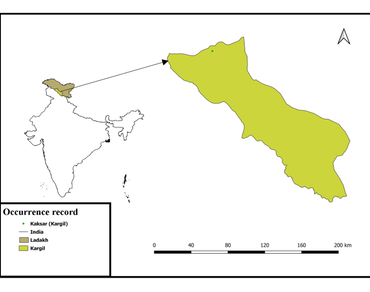Trees of the Trans-Himalaya: first report of Pinus wallichiana A. B. Jackson from Ladakh
Research Articles | Published: 04 November, 2022
First Page: 1239
Last Page: 1244
Views: 3984
Keywords: Distribution, Himalaya, Taxonomy, Ladakh, Tree
Abstract
Documenting distribution records of biodiversity at regional scale plays a pivotal role in bridging the Wallacean shortfall in global knowledge on biodiversity. Here, we reported the first distribution record of a tree species, Pinus wallichiana A. B. Jackson to the flora of Ladakh – a remote region in Indian Trans-Himalaya. The tree species grows wild in the interior mountain valley of Kaksar in district Kargil of the region. Taxonomic description and photographic illustrations of the species are provided here to facilitate easy identification. We also highlighted the scientific significance of this new tree species record in better understanding of biogeography, paleoecology and paleo-climate of this remote Trans-Himalayan region in India.

References
Asad F, Zhu H, Liang E, Ali M, Hamayun M, Sigdel SR, Khalid M, Hussain I (2017) Climate signal in tree-ring width chronologies of Pinus wallichiana from the Karakoram mountains in Northern Pakistan. Pak J Bot 49(6):2466–2473
Banoo S, Ganie AH, Khuroo AA (2022) Pedicularis gracilis var. brunoniana (Wall. ex Pennell) T. Husain & Arti Garg: first report from Ladakh, Trans-Himalaya, India. Check List 18(2):269–273. https://doi.org/10.15560/18.2.269
Behera MD, Matin S, Roy PS (2014) Biodiversity of Kargil cold desert in the Ladakh Himalaya. Integrative Observations and Assessments. Springer, Tokyo, pp 253–274. https://doi.org/10.1007/978-4-431-54783-9_13
Bhandari LL, Venkatachala BS, Singh P (1977) Stratigraphy, palynology and palaeontology of Ladakh Molasse Group in the Kargil area, In Proceedings of the 4th Indian Colloquium on Micropalaeontology & Stratigraphy, Dehradun 127: 133
Bridson DM, Forman L (1998) Herbarium handbook. Royal Botanic Gardens, Kew, pp 2–261
Dar GH, Khuroo AA (2020) An updated taxonomic checklist of angiosperms in Jammu and Kashmir state. In: Dar GH, Khuroo AA (eds) Biodiversity of the Himalaya: Jammu and Kashmir State. Springer, Singapore, pp 467–519
Dhar U (2002) Conservation implications of plant endemism in high-altitude Himalaya. Curr Sci 82(2):141–148. https://www.jstor.org/stable/24106104
FoC (2008) Flora of China. Available via http://www.eforas.org/. Accessed 12 Sep 2021
Gaire NP, Dhakal YR, Shah SK, Fan ZX, Bräuning A, Thapa UK, Bhandari S, Aryal S, Bhuja DR (2019) Drought (scPDSI) reconstruction of trans-Himalayan region of central Himalaya using Pinus wallichiana tree-rings. Palaeogeogr Palaeoclimatol Palaeoecol 514:251–264
Guleria JS, Thakur VC, Virdi NS, Lakhanpal RN (1983) A fossil wood of Prunus from the Kargil (= Liyan) Formation of Ladakh, Geology of Indus Suture Zone of Ladakh. Wadia Inst. Himalayan Geol., Dehradun, pp187–193. https://doi.org/10.1016/j.palaeo.2018.10.026
Gulzar R, Khuroo AA, Hassan T (2022) Veronica polita subsp. lilacina (Plantaginaceae), a new plant record for India from. Kashmir Himalaya. Rheedea 32(1):1–5. https://doi.org/10.22244/rheedea.2022.32.01.07
Hamid M, Khuroo AA, Malik AH, Ahmad R, Singh CP (2020) Assessment of alpine summit flora in Kashmir Himalaya and its implications for long-term monitoring of climate change impacts. J Mt Sci 17(8):1974–1988. https://doi.org/10.1007/s11629-019-5924-7
Hortal J, de Bello F, Diniz-Filho JAF, Lewinsohn TM, Lobo JM, Ladle RJ (2015) Seven shortfalls that beset large-scale knowledge of biodiversity. Annu Rev Ecol Evol Syst 46(1):523–549
Islam T, Gulzar R, Singh G, Nawchoo IA, Khuroo AA (2022) Misidentification impedes invasion management: report of Matricaria discoidea DC., an invasive alien species in Kashmir Himalaya. Vegetos 35:551–557. https://doi.org/10.1007/s42535-021-00328-5
Joshi PK, Rawat GS, Padilya H, Roy PS (2006) Biodiversity characterization in Nubra Valley, Ladakh with special reference to plant resource conservation and bioprospecting. Biodivers Conserv 15(13):4253–4270
Klimes L, Dickore B (2006) Flora of Ladakh (NW Himalaya): a preliminary checklist. https://www.butbn.cas.cz/klimes/desert.html
Koul MN, Bahuguna IM, Rajawat AS, Ali S, Koul S (2016) Glacier area change over past 50 years to stable phase in Drass valley, Ladakh Himalaya (India). Am J Clim Change 5:88–102. https://doi.org/10.4236/ajcc.2016.51010
Kumar K, Nanda AC, Tiwari BN (1996) Rodents from the Oligo-Miocene Kargil Formation, Ladakh, India: biochronologic and palaeobiogeographic implications. Neues Jahrbuch fur Geologie and Palaontologie Abhandlungen 202:383–407
Lakhanpal RN, Prakash G, Thussu JL, Guleria JS (1984) A fossil fan from the Liyan formation of Ladakh (Jammu and Kashmir). Palaeobot 31:201–207
Lomolino MV, Riddle BR, Whittaker RJ (2017) Biogeography, fifth edition. Oxford University Press, Sunderland, MA, pp 730.
Mathur NS, Juyal KP (2000) Paleontological evidence for the upheaval history of western Himalaya during the Paleogene. Himal Geol 21(1):109–131
Mehrotra RC, Kumar M, Ghosh AK, Kumar K, Arya (2014) Plant Remains from the Tharumsa Formation of Ladakh, India. J Geol Soc India 83(6):647–652
Nanda AC, Sahni A(1990) Oligocene vertebrates from the Ladakh Molasse Group, Ladakh Himalaya: palaeobiogeographic implications. Journal of Himal Geol 1:1–10.
Nanda AC, Sahni A (1998) Ctenodactyloid rodent assemblage from Kargil Formation, Ladakh Molasse Group: Age and palaeobiogeographic implications for the Indian subcontinent in the Oligo-Miocene. Geobios 31:533–544
Paul SK, Mehrotra RC, Sharma A, Phartiyal B, Dorjey CP (2007) A new fossil palm leaf from the Hemis Formation of Ladakh, Jammu and Kashmir, India. Curr Sci 92(6):727–729
Polunin O, Stainton A (1984) Flowers of the Himalaya. Oxford University Press
POWO (2020) Plants of the World Online. Facilitated by the Royal Botanic Gardens, Kew. Available via http://www.plantsoftheworldonline.org/. Accessed 10 Dec 2021
Prasad GVR, Bajpai S, Singh S, Parmar V (2005) First cricctid rodent (Mammalia) from Ladakh molassc, northwestern Himalaya, India: Age implications. Himal Geol 26:85–92
Schickhoff U (2005) The upper timberline in the Himalayas, Hindu Kush and Karakorum: a review of geographical and ecological aspects. Mountain ecosystems, pp 275–354
Seyfullah LJ, Beimforde C, Dal Corso J, Perrichot V, Rikkinen J, Schmidt AR (2018) Production and preservation of resins–past and present. Biol Rev 93(3):1684–1714
Shah SK, Pandey U, Mehrotra N, Wiles GC, Chandra R (2019) A winter temperature reconstruction for the Lidder Valley, Kashmir, Northwest Himalaya based on tree-rings of Pinus wallichiana. Clim Dyn 53(7):4059–4075
Stewart RR, Nasir E, Ali SI (1972) Flora of West Pakistan: An Annotated Catalogue of the Vascular Plants of West Pakistan and Kashmir. Fakhri Printing Press, Karachi
WFO (2020) World Flora Online. Available via http://www.worldforaonline.org/. Accessed 12 Dec 2021
Author Information
Centre for Biodiversity & Taxonomy, Department of Botany, University of Kashmir, Srinagar, India